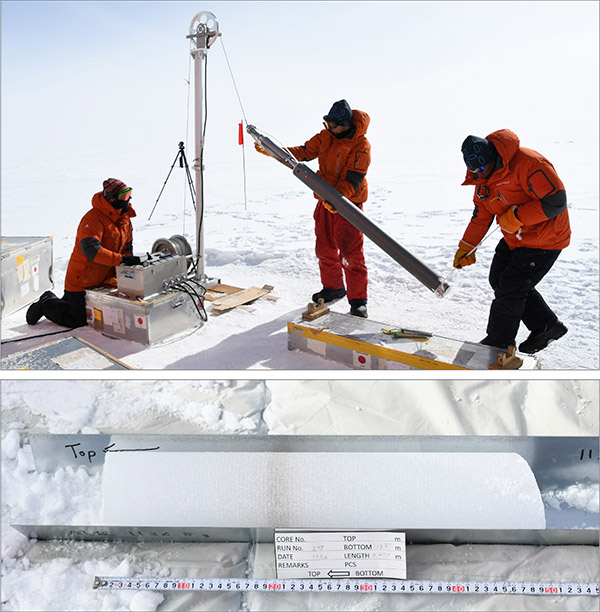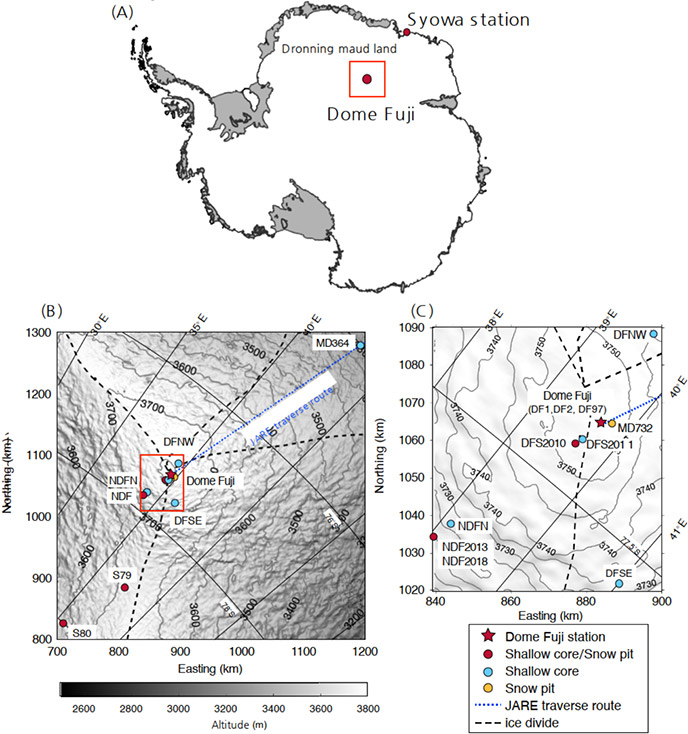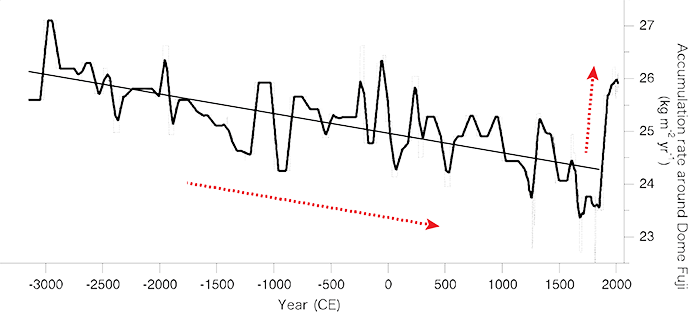National Institute of Polar Research
Snow cover in the Antarctic interior has decreased over the past 5,000 years, with a marked increase since the Industrial Revolution -Clarified from ice cores in the Dome Fuji area, Antarctica-
Published on February 22, 2023
Posted on March 31, 2023
A research group led by Ikumi Oyabu of the National Institute of Polar Research (NIPR) has analyzed multiple ice cores (Figure 1) drilled at and around the Dome Fuji station in the Antarctic interior (Figure 2) to precisely estimate snow cover variations over the past 5000 years. Because the Antarctic interior is so large, even small changes in snow cover impact ice sheet mass changes. However, measuring these changes has been difficult due to the extremely low annual snowfall. The authors found a long-term decrease in snow cover over the last 5000 years, followed by a significant increase after the Industrial Revolution (~150 years ago) (Figure 3). The long-term decrease may be caused by long-term surface cooling over the Southern Ocean and East Antarctica and sea ice expansion in the moisture source area, while the subsequent increase may be attributed to an increase in greenhouse gas concentrations and stratospheric ozone depletion. These results are important for understanding the relationship between the Antarctic ice sheet mass balance and climate change, as well as for validating climate and ice sheet models for future predictions.

Figure1: Ice core drilling at the NDF site by the 59th Japanese Antarctic Research Expedition (see Figure 2(B)) (top) and the NDF2018 ice core with volcanic ash layer (bottom). The age of the layer is estimated to be 1613 BCE.

Figure2: (A) Overall view of the Antarctic ice sheet. (B, C) Expanded view of the Dome Fuji region targeted in this study.

Figure3: Mean accumulation rate around Dome Fuji over the last 5000 years.
Original article:
Journal: Climate of the Past, Volume 19, issue 2
Title: Temporal variations of surface mass balance over the last 5000 years around Dome Fuji, Dronning Maud Land, East Antarctica.
Authors:
Ikumi Oyabu (National Institute of Polar Research, Japan)
Kenji Kawamura (National Institute of Polar Research, Japan)
Shuji Fujita (National Institute of Polar Research, Japan)
Ryo Inoue (Department of Polar Science, The Graduate University for Advanced Studies, SOKENDAI, Japan)
Hideaki Motoyama (National Institute of Polar Research, Japan)
Kotaro Fukui (Tateyama Caldera Sabo Museum, Japan)
Motohiro Hirabayashi (National Institute of Polar Research, Japan)
Yu Hoshina (Graduate School of Environmental Studies, Nagoya University, Japan)
Naoyuki Kurita (Institute of Space-Earth Environmental Science, Nagoya University, Japan)
Fumio Nakazawa (National Institute of Polar Research, Japan)
Hiroshi Ohno (School of Earth, Energy and Environmental Engineering, Kitami Institute of Technology, Japan)
Konosuke Sugiura (School of Sustainable Design, University of Toyama, Japan)
Toshitaka Suzuki (Faculty of Science, Yamagata University, Japan)
Shun Tsutaki (National Institute of Polar Research, Japan)
Ayako Abe-Ouchi (Atmosphere and Ocean Research Institute, The University of Tokyo, Japan)
Masashi Niwano (Physical Meteorology Research Department, Meteorological Research Institute,Japan Meteorological Agency, Japan)
Frédéric Parrenin (Institut des Géosciences de l'Environnement, Université Grenoble Alpes, France)
Fuyuki Saito (Japan Agency for Marine Science and Technology, Japan)
Masakazu Yoshimori (Atmosphere and Ocean Research Institute, The University of Tokyo, Japan)
DOI: 10.5194/cp-19-293-2023
URL: https://doi.org/10.5194/cp-19-293-2023
Published: February 2, 2023








